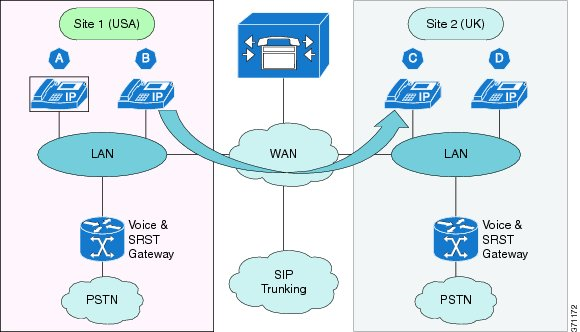Inter-Site On-Net Call¶
The deployment model supports multiple sites with overlapping extensions and inter-site calling by dialing the Site Location Codes prefixed with an inter-site prefix, and supports the following dialing capabilities:
- Inter-site dialing prefix
- Variable length extensions between sites with no post-dialing delay (PDD) cause by timeout
When the user dials a directory number of another user, the leaf cluster first examines the site code, and determines if the site code is for a site on the same cluster or another cluster. If the site is on the same cluster, the call is routed to the correct location and delivered to the phone. If the site code is for a site on a different cluster, routing is as described in the following section.
This call type occurs between two endpoints located on different sites. The sites can be on a different Cisco Unified Communications Manager that belongs to the same customer. As shown in the following figure, media traffic is between the endpoints.
On-Net Call (Inter-Site)

| Usage |
|
| Accessibility | User can perform On-Net call from any endpoint registered with Cisco Unified Communications Manager |
| Usage Example | Reduces costs of Inter-site and International calls by sharing available bandwidth with Data Network |
| Default Configuration | Available to all users |
| Configuration Choices |
|
| Redundancy | Available to users without restrictions |
| Survivability | Not available to users in fallback mode |
| Endpoint Types Supported |
|
| Examples | Case 1: DN = ISP+SLC+Extension
Phone B (DN=8 100 2345)
Dial 8 200 6789 (for Phone C)
Phone B Connected Number shows 8 200 6789
Phone C (DN=8 200 6789)
On Answer, display shows 8 100 2345 -Calling Party Number
Case 2: DN = SLC+Extension; Extension Prefix is used for
Extension dialing (for example 6)
Phone A (DN=300 4040)
Dial 300 4050 (Phone B extension)
Phone D Connected Number shows 300 4050
Phone D (DN=300 4050)
On Answer display shows 300 4040 -Calling Party Number
Case 3: DN= Extension {Dialing with full DN}
Phone A (DN=40404040)
Dial 40404050 (Phone D extension)
Phone A Connected Number shows 40404050
Phone D (DN=40404050)
On Answer display shows 40404040 as the Calling
Party Number
|
